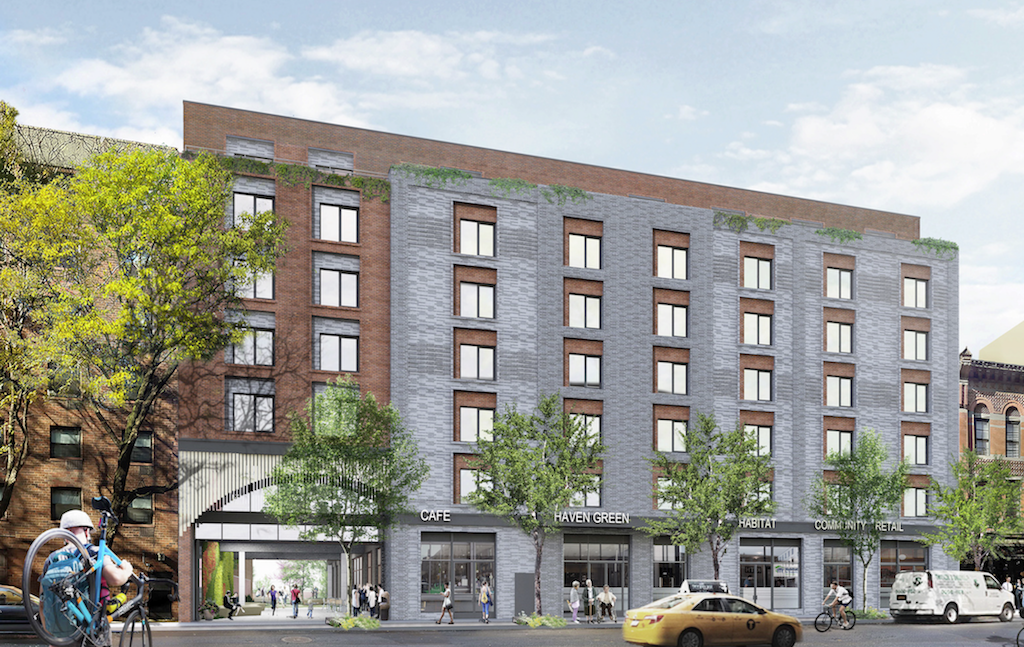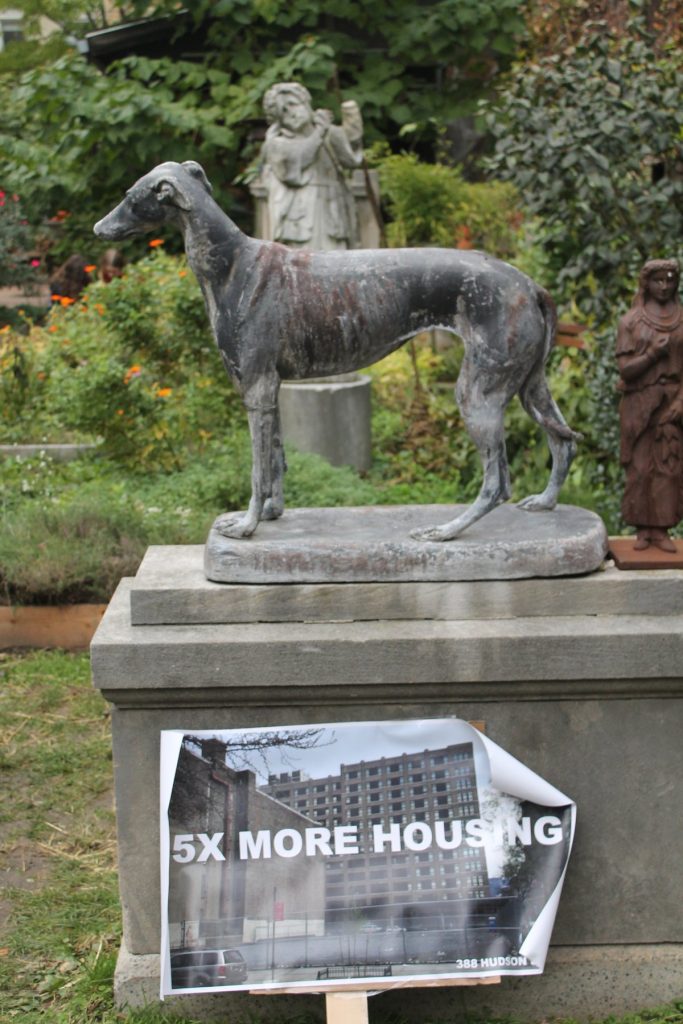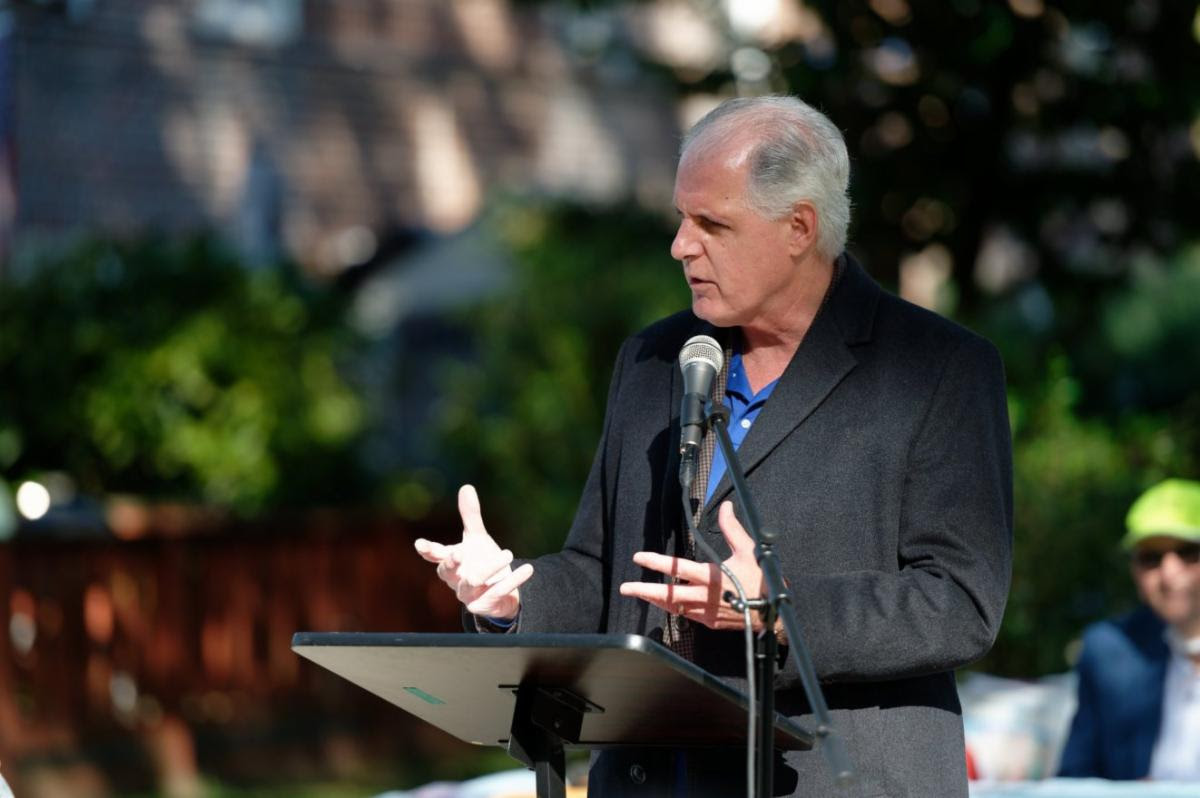
BY SARAH FERGUSON | Updated Tues., Jan. 22, 2 p.m.: It was high drama last week at the Sheen Center’s Loreto Theater on Bleecker St., as community members and housing advocates faced off at the final public hearing of the Elizabeth St. Garden Working Group.
The working group was tasked by Community Board 2 to formally assess the city’s plan to replace the iconic sculpture garden in Little Italy with 123 units of “deeply affordable” L.G.B.T.-friendly senior housing.
While C.B. 2 has consistently opposed the so-called Haven Green project, the board is required to respond to how the proposed development would impact the neighborhood. The working group’s final resolution will be put to a vote by the full community board this Thurs., Jan. 24.
Emotions ran high as fans and predominantly foes of the proposed housing project lined up to express their views. Not surprisingly, the C.B. 2 members of the working group took issue with the city’s Environmental Assessment Statement, which found that the loss of the garden would not have a significant impact on the surrounding community.
That “negative declaration” allows the city to fast-track the project through its Uniform Land Use Review Process (ULURP) rather than undergo a lengthier Environmental Impact Statement.
Rich Caccappolo, chairperson of the C.B. 2 Parks Committee, said the loss of 70 percent of the existing garden to housing was significant in a neighborhood so underserved by open space, and said that fact should have triggered the need for a full environmental review.
He called the city’s claim of preserving more than 8,000 square feet of open space at the site “misleading.” About 1,700 square feet would be beneath a covered walkway, and the remaining park space would be cast in shadow for much of the day, he said, making the grassy lawn depicted in the project renderings “unsustainable.”
Caccappolo questioned why Habitat for Humanity, one of the three project sponsors, had been allocated 11,200 square feet of ground-floor office space.
“Why aren’t they using that to expand the number of apartments or green space?” concurred David Gruber, the working group’s chairperson.

Also speaking were the lawyers for the two garden preservation groups. Civil-rights attorney Norman Siegel is representing Elizabeth St. Garden, Inc., the group currently running the garden. He argued the project flies in the face of the environmental-sustainability goals laid out by the de Blasio administration’s OneNYC plan.
“These policies promote increasing, not destroying, open green space in the city and planting more trees, which can have a positive impact on air quality, storm-water runoff, energy consumption and climate change,” Siegel said.
“Climate change is real folks,” Siegel declared, prompting loud cheers and a few jeers.
“So is homelessness in New York City!” shouted a proponent of the new housing.
Similarly, Michael Gruen, the lawyer representing the group Friends of Elizabeth St. Garden, faulted the city’s E.A.S. for “illogically” claiming that the loss of the garden would have little impact — because there already is so little open space in the Little Italy/NoHo area.
“That paucity of open space is precisely what makes this garden so valuable,” Gruen countered.
Many longtime residents decried the city’s assault on this “unique” and “one-of-a-kind” oasis — what one supporter called the “heart of the community.”
“This park, no matter where you go in the world, people have heard about it,” said chef Frank DeCarlo, who said he was inspired to open his upscale Peasant restaurant on the block because of the garden.
“One-third of the block is already public housing,” DeCarlo noted, referring to the subsidized Section 8 housing project that sits adjacent to the garden to its south. “Why does two-thirds of it need to be that?”

Such comments drew fire from K Webster of the Sara D. Roosevelt Park Coalition, who accused garden supporters of ignoring the city’s dire homeless crisis.
“I am so f—king ashamed of you,” she shouted at the board members, prompting Gruber to kick her out of the meeting for cussing.
Val Orselli of the Cooper Square Mutual Housing Association said C.B. 2 members were being “intellectually dishonest” by ignoring the proximity of Sara D. Roosevelt Park, and suggested the committee should lobby the city’s Parks Department to move the Elizabeth St. Garden’s statuary there instead.
“This garden isn’t an example of community but of gentrification,” he claimed of the Little Italy green oasis.

There was also a posse of placard-waving activists from Open New York, a pro-development “YIMBY” group that lobbies for more housing in wealthy or high-demand areas, on the theory that expanding supply will lower rents for everyone.
But others, including Siegel, called out the city for dividing the community by not choosing an alternative site for the project — such as the larger city-owned lot at 388 Hudson St. that C.B. 2 favors.
“As important as affordable housing is, we don’t pit affordable housing against open space,” Siegel told the crowd. “We should not do what’s happening across the country under Trump and divide each other.”
As the meeting went into executive session, the working group committee members were debating whether to present the city with a resolution rejecting the Haven Green project outright, or to press for compromises that might save more green space.
“No one even asked if we could go two stories higher and build more housing and also gain more open space,” Gruber noted.
Former C.B. 2 Chairperson Tobi Bergman suggested altering the building’s “inefficient T-shape” to allow for a more viable park space.
“What’s our leverage?” Gruber asked. “We’re in this position of grasping at straws.”
The community board has only advisory power, he noted, and the city’s decision to issue an E.A.S. instead of a more rigorous E.I.S. means the board has even less input in the design.
The real power lies with the project’s backer, Councilmember Margaret Chin, who can ensure the project gets voted up by the City Council. Chin, Gruber noted, has declined to appear before the E.S.G. Working Group or take phone calls.



































